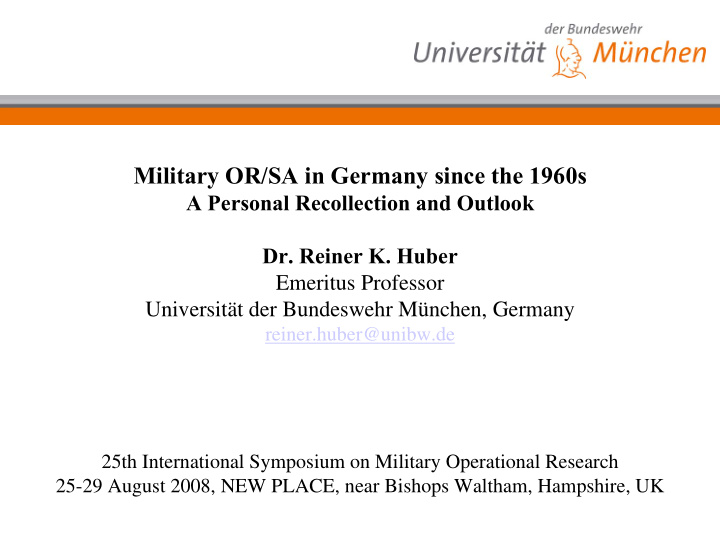



Military OR/SA in Germany since the 1960s A Personal Recollection and Outlook Dr. Reiner K. Huber Emeritus Professor Universität der Bundeswehr München, Germany reiner.huber@unibw.de 25th International Symposium on Military Operational Research 25-29 August 2008, NEW PLACE, near Bishops Waltham, Hampshire, UK
Milestones 1 • 1959: EWR (Bölkow- Messerschmitt - Heinkel) installs OR group to support its R&D • 1961: German MoD hires experienced Northrop OR team (ORG) to evaluate VTOL designs and train EWR analysts on the job • 1963: ORG becomes part of MoD-owned IABG • 1963: Military advisory group attached to ORG • 1964: ORG subdivided into ORL (Air Force OR) and ORM (Naval OR) • 1966: ORG complemented by ORH (Army)
Milestones 2 • 1972: Functional re-organization of ORG under IABG‘s Study Diectorate : SO (operations): combat modelling and analysis inluding wargaming SZ (central functions): intelligence, C2, defence economics SV (support functions): logistics, medical, planning systems, • 1973: Univ. Bw Munich - MOR (part computer science curriculum) • 1980: Institute of Applied Systems and Operations Research (IASFOR) • 1993: Institute for Technology of Intelligent Systems (ITIS) e.V. • 1993: IABG privatised • 2002: Center for Transformation of the Bundeswehr (ZTransfBw)
Characteristic Phases of German Military OR/SA � 1960s-1970s: Weapon Systems-oriented OR/SA � 1970s-1980s: Defence System-oriented OR/SA � 1990s-2000s: Stability and Defence Reform-oriented OR/SA � since 2002: Transformation-oriented OR/SA -
Weapon Systems-oriented OR/SA ( 1960s-1970s) � F 104G Improvement � US/FRG V/STOL design assessment � Requirements for new tactical fighter � Air wing support operations planning � Field experiments � FORKS / COFORKS wargames � OPS War Gaming System � Theatre-level Staff Exercise Support (Bw Planübung 1970)
Defence Systems-oriented OR/SA (1970s-1980s) � Driving Issues: MBFR and LTDP � Model developments: Hierarchical Gaming Systems - COFORCS → KORA → RELACS - SIRA → HORUS → JOANA • Studies: - Force Reduction Options (MBFR) - „ 90 Days Study“
Defence Systems-oriented OR/SA cont‘d (IASFOR) Driving Issues: - Alternative Defence Debate - Conventional Stability in Europe (VW Research Grant) � Model developments: - GEFRAM - KOSMOS • Studies: - Alternative Defense Options - Stable Defence (NATO-DRG Panel 7 RSG 18)
Stability and Defence-Reform-oriented OR/SA (1990s -2000s) � Driving Issues: - Post-Cold War Stability and NATO Enlargement - Analytical Framework for Restructuring Military Forces - Strategic Uncertainty and Force Planning � Studies / Research: - NATO Enlargement: Russian Security and Costs - Limits of German Defence Reform - Modelling the impact of randomly occuring SASO
Transformation-oriented OR/SA (since 2002) Modelling Activities (Contractors) • Adaptation of models and simulations to new tasks (EBAO) • Adaptation of training simulators for joint operations • Linking simulation systems with life C2 • Modelling human behavior • Agent-based modeling experiments for identfying relevant decision variables in complex operations • Knowledge base development • Integrated simulation and test environment
Transformation-oriented OR/SA (since 2002) (Institute for Technology of Intelligent Systems (ITIS) e.V.) Conceptual C2 Modeling • SAS-026 (COBP for C2 Assessment) • SAS-050 (Exploring new C2 Concepts) • SAS-065 (NATO NEC C2 Maturity Model) Empirical Research • Impact of individual and team chacrteristics on the performance of small networked teams
Recommend
More recommend